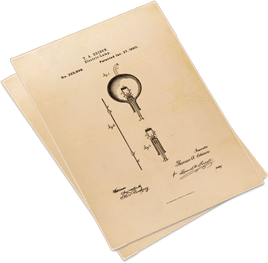Apparently now you can. Since time immemorial – or at least for a couple hundred years – the fashion industry has wished, hoped, lobbied, and otherwise prayed for copyright protection for articles of clothing. A recent Supreme Court ruling in Star Athletica, LLC v. Varsity Brands, Inc., may have tilted the matter in favor of the mavens of couture. The case came to the Court to determine if Varsity Brands’ registered copyrights in designs of or on cheerleader uniforms could be enforced against Star Athletica’s copies.
A bit of history
Historically, some features associated with fashion have always had copyright protection – for instance, designs printed on fabric or fixed in fabric (e.g., lace, embroidery) – as long as the art on or in the fabric was able to be expressed separately and copied in other media such as prints, coffee mugs, and wall hangings. But fashion designers have been after copyright protection of the article of clothing as a work of art in three dimensions. And until now the Copyright Office and U.S. law in general have denied this protection, seeing clothing, no matter its shape and detail, as wholly functional1 and excluded from copyright protection.
What the Court said
The Court set out to resolve a long-standing confusion about the difference between “industrial design” (the non-functional design of articles of manufacture which the U.S. protects in design patents) and “works of art” (protected by copyright) and to define the line that separates these2, and how that difference must be examined in light of the relevant part of Section 101 of the Copyright Act, which says that “the design of a useful article, as defined in this section, shall be considered a pictorial, graphic, or sculptural work only if, and only to the extent that, such design incorporates pictorial, graphic, or sculptural features that can be identified separately from, and are capable of existing independently of, the utilitarian aspects of the article.”
The registered designs that Varsity claimed Star infringed were these:
Star Athletica defended the infringement action arguing that only the drawings of the designs were protected, and they were free to copy the uniforms.
In applying the language of the statute to cheerleader uniforms, and by extension clothing, however, the court clarified that designs applied to any “canvas” were protected, even as applied to the cheerleader uniforms. Tracking close to time-tested principle of “separability,” alluded to above, The Court wrote, “We hold that a feature incorporated into the design of a useful article is eligible for copyright protection only if the feature (1) can be perceived as a two- or three-dimensional work of art separate from the useful article and (2) would qualify as a protectable pictorial, graphic, or sculptural work – either on its own or fixed in some other tangible medium of expression – if it were imagined separately from the useful article into which it is incorporated.” The Court went on to reason that the designs expressed as “arrangements of lines, chevrons, and colorful shapes” in Varsity Brands’ uniforms could be imagined and expressed in other media in the same way that, in one example, “a design etched or painted on the surface of a guitar … removed from the guitar’s surface and placed on an album cover” satisfies the separability principle even though the copied design “would still resemble the shape of a guitar,” the original “canvas,” while it does not “‘replicate’ the guitar as a useful article.”
The Courts point is that any pictorial or graphic work necessarily takes the shape of the “canvas” on which it was created, such as frescos painted on walls, ceilings, or domes of buildings. More specifically, the Court concluded that the protected art in this case are the designs “fixed in the tangible medium of the cheerleading uniforms” and not the “shape, cut, and dimensions” of the uniforms. So that anyone can make a cheerleader’s uniform in the shape and style of, well, a cheerleader’s uniform, but Varsity Brands has the right to prohibit and sue for infringement of their copyrighted designs when those designs are reproduced on cheerleaders’ uniforms or any other medium
Of course the Court’s clarification of the separability principle does not appear to completely grant the fashion industries wishes. Few Supreme Court decisions provide, or could ever provide such clarity that ends all argument, and this decision will likely be parsed in its most minute detail in court battles to come. But the Court has settled a greater part of this long-running controversy in the fashion industry’s favor.
1 It bears noting that design patent protection has been granted to clothing designs (for example, Design Patent No. D744,723). Design patents protect only the ornamental features of articles of manufacture.
2 You might ask why anyone would want copyright protection of an article of clothing if design patent protection is available. Putting aside the question of whether a particular article might be awarded design patent protection, the answer to that is that design patent protection typically costs around $2,500.00, protects the ornamental design of the manufactured item of clothing, only, and only as pictured in the patent drawings, and the life of a design patent is just fourteen years. By contrast, copyright protection endures for the life of the designer plus 70 years (or for 95 years after publication or 120 years after creation if the “author” of the design is a company), the cost of copyright registration is a few hundred dollars or less, and the protection extends to “substantially similar” copies in any media.



